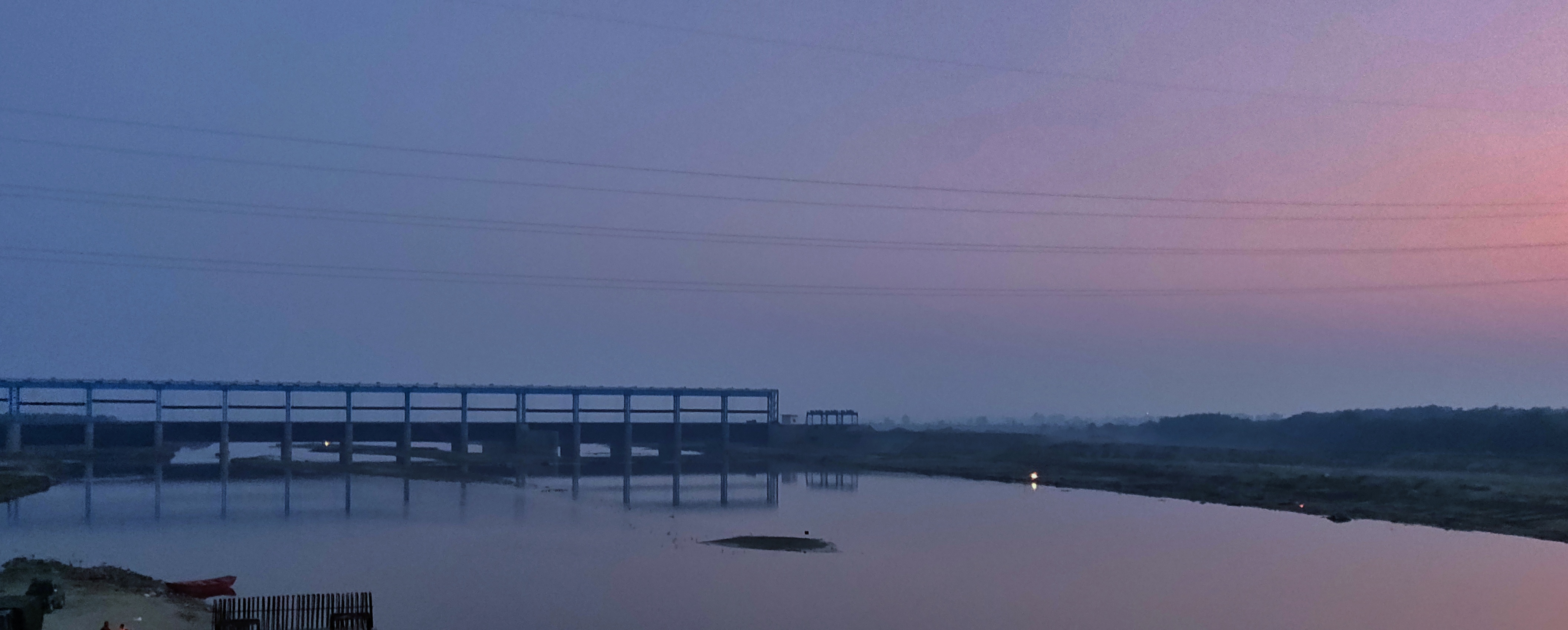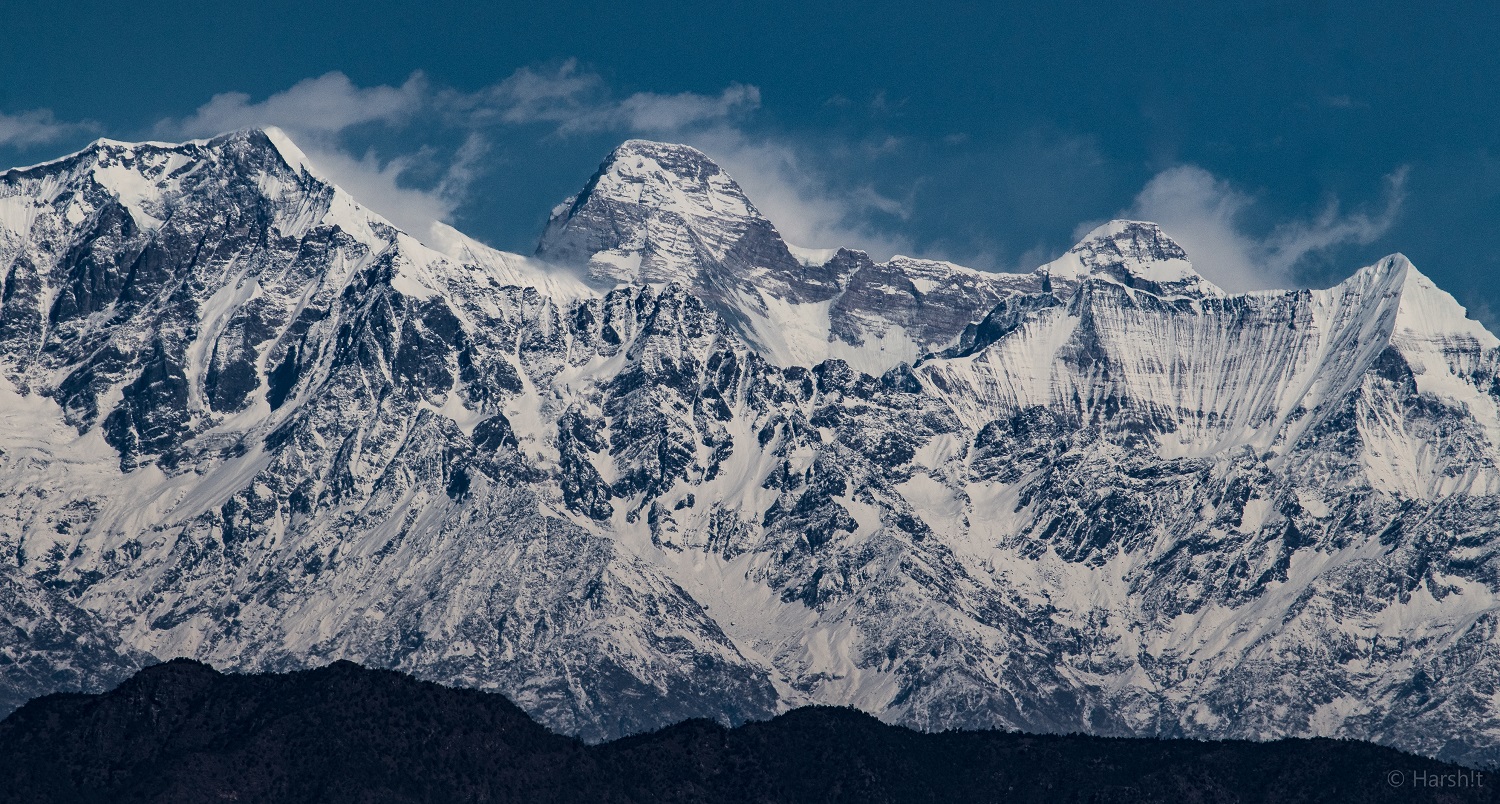|
Namik Glacier
Namik Glacier is situated in the Pithoragarh district of Uttarakhand state in India. Geography The glacier is situated on the Kumaon Himalayas at an altitude of . This glacier is the source of the Ramganga River. The glacier is surrounded by the following peaks: Nanda Devi , Nanda Kot , and Trishuli . The glacier falls on ancient Indo-Tibet trade route. It is trekking from Liti and situated at the villages of Gogina and Namik. There are a number of waterfalls and sulphur springs originating around this glacier. The glacier can be reached by trekking from gogina on the sama liti Road near. It is from Bageshwar. Jeeps can be hired from Bageshwar or Kapkot up to Gogina. 'Namik' means a place where saline water springs are present. See also * List of glaciers A glacier ( ) or () is a persistent body of dense ice that is constantly moving under its own weight; it forms where the accumulation of snow exceeds its ablation (melting and sublimation) over many years, often cent ... [...More Info...] [...Related Items...] OR: [Wikipedia] [Google] [Baidu] |
Kumaon Division
Kumaon (; , ; historically romanised as KemāonJames Prinsep (Editor)John McClelland ) is a List of divisions in India, revenue and administrative division in the Indian state of Uttarakhand. It spans over the eastern half of the state and is bounded on the north by Tibet, on the east by Nepal, on the south by the state of Uttar Pradesh, and on the west by Garhwal Division, Garhwal. Kumaon comprises six districts of the state: Almora district, Almora, Bageshwar district, Bageshwar, Champawat district, Champawat, Nainital district, Nainital, Pithoragarh district, Pithoragarh and Udham Singh Nagar district, Udham Singh Nagar. Historically known as Manaskhand and then Kurmanchal, the Kumaon region has been ruled by several dynasties over the course of history; most notably the Katyuri kings, Katyuris and the Chand kings, Chands. The Kumaon division was established in 1816, when the British reclaimed this region from the Gorkha Kingdom, Gorkhas, who had annexed the erstwhile Kumaon ... [...More Info...] [...Related Items...] OR: [Wikipedia] [Google] [Baidu] |
Himalayas
The Himalayas, or Himalaya ( ), is a mountain range in Asia, separating the plains of the Indian subcontinent from the Tibetan Plateau. The range has some of the Earth's highest peaks, including the highest, Mount Everest. More than list of highest mountains on Earth, 100 peaks exceeding elevations of above sea level lie in the Himalayas. The Himalayas abut on or cross territories of Himalayan states, six countries: Nepal, China, Pakistan, Bhutan, India and Afghanistan. The sovereignty of the range in the Kashmir region is disputed among India, Pakistan, and China. The Himalayan range is bordered on the northwest by the Karakoram and Hindu Kush ranges, on the north by the Tibetan Plateau, and on the south by the Indo-Gangetic Plain. Some of the world's major rivers, the Indus River, Indus, the Ganges river, Ganges, and the Yarlung Tsangpo River, Tsangpo–Brahmaputra River, Brahmaputra, rise in the vicinity of the Himalayas, and their combined drainage basin is home to some 6 ... [...More Info...] [...Related Items...] OR: [Wikipedia] [Google] [Baidu] |
Uttarakhand
Uttarakhand (, ), also known as Uttaranchal ( ; List of renamed places in India, the official name until 2007), is a States and union territories of India, state in North India, northern India. The state is bordered by Himachal Pradesh to the northwest, Tibet to the north, Nepal to the east, Uttar Pradesh to the south and southeast, with a small part touching Haryana in the west. Uttarakhand has a total area of , equal to 1.6% of the total area of India. Dehradun serves as the state capital, with Nainital being the judicial capital. The state is divided into two divisions, Garhwal division, Garhwal and Kumaon division, Kumaon, with a total of List of districts of Uttarakhand, 13 districts. The forest cover in the state is 45.4% of the state's geographical area. The cultivable area is 16% of the total geographical area. The two major rivers of the state, the Ganges and its tributary Yamuna, originate from the Gangotri and Yamunotri glaciers respectively. Ranked 6th among the Top 1 ... [...More Info...] [...Related Items...] OR: [Wikipedia] [Google] [Baidu] |
India
India, officially the Republic of India, is a country in South Asia. It is the List of countries and dependencies by area, seventh-largest country by area; the List of countries by population (United Nations), most populous country since 2023; and, since its independence in 1947, the world's most populous democracy. Bounded by the Indian Ocean on the south, the Arabian Sea on the southwest, and the Bay of Bengal on the southeast, it shares land borders with Pakistan to the west; China, Nepal, and Bhutan to the north; and Bangladesh and Myanmar to the east. In the Indian Ocean, India is near Sri Lanka and the Maldives; its Andaman and Nicobar Islands share a maritime border with Thailand, Myanmar, and Indonesia. Modern humans arrived on the Indian subcontinent from Africa no later than 55,000 years ago., "Y-Chromosome and Mt-DNA data support the colonization of South Asia by modern humans originating in Africa. ... Coalescence dates for most non-European populations averag ... [...More Info...] [...Related Items...] OR: [Wikipedia] [Google] [Baidu] |
Pithoragarh District
Pithoragarh district is the easternmost district in the state of Uttarakhand. It is located in the Himalayas and has an area of and a population of 483,439 (as of 2011). The city of Pithoragarh, located in Saur Valley, is its headquarters. The district is within the Kumaon division of Uttarakhand state. The Tibet plateau is situated to the north and Nepal is to the east. The Kali River (Uttarakhand), Kali River which originates from the Kalagiri Mountain flows south, forming the eastern border with Nepal. The Hindu pilgrimage route for Mount Kailash-Lake Manasarovar passes through this district via Lipulekh Pass in the greater Himalayas. The district is administratively divided into six Tehsils: Munsyari; Dharchula; Didihat; Berinag; Gangolihat; and Pithoragarh. Naini Saini Airport is the nearest civil airport, but it does not have a regular scheduled commercial passenger service. The mineral deposits present in the district are magnesium ore, copper ore, limestone, and slate. ... [...More Info...] [...Related Items...] OR: [Wikipedia] [Google] [Baidu] |
Ramganga
Ramganga is a tributary of the river Ganges, originating in Uttarakhand state, India. Ramganga West Ramganga West River originates from Dudhatoli or Doodhatoli ranges Course The Ramganga River originates in the southern slopes of Dudhatoli Hill in Chamoli district of the Indian state of Uttarakhand. The source of the river, known as "Diwali Khal", is located in Gairsain tehsil at . The river flows by the town of Gairsain, however the town is located at a much higher altitude than the river. The river then enters the Almora district of Kumaon division, Kumaon through a deep and narrow valley in Chaukhutia tehsil. Emerging from there, it turns southwest and receives the Tadagatal River, wandering widely around the southeastern boundary of Lohabagarhi. It then proceeds further in the same direction and reaches Ganai, where it receives the Kharogad coming from Dunagiri from the left and Khetasargad coming from Pandnakhal from the right. Coming out of Ganai, it flows towards t ... [...More Info...] [...Related Items...] OR: [Wikipedia] [Google] [Baidu] |
Nanda Devi
Nanda Devi is the second-highest mountain in India, after Kangchenjunga, and the highest located entirely within the country. (Kangchenjunga is on the border of India and Nepal.) Nanda Devi is the 23rd-highest peak in the world and ranked 74th by prominence . Nanda Devi was considered the highest mountain in the world before computations in 1808 proved Dhaulagiri to be higher. It was also the highest mountain in India until 1975, when Sikkim, an independent kingdom until 1948 and a protectorate of India thereafter, became a state of India. It is located in the Chamoli district of Uttarakhand, between the Rishiganga valley on the west and the Goriganga valley on the east. The peak, whose name means "Bliss-Giving Goddess", is regarded as the patron goddess of the Garhwal and Kumaon Himalayas. In acknowledgment of its religious significance and for the protection of its fragile ecosystem, the Government of India declared the peak as well as the circle of high mountains ... [...More Info...] [...Related Items...] OR: [Wikipedia] [Google] [Baidu] |
Nanda Kot
Nanda Kot ( Kumaoni-नन्दा कोट) is a mountain peak of the Himalaya range located in the Pithoragarh district of Uttarakhand state in India. It lies in the Kumaon Himalaya, just outside the ring of peaks enclosing the Nanda Devi Sanctuary, southeast of Nanda Devi itself. The name Nanda Kot literally means "Nanda's Fortress" and refers to the abode of one of the sacred forms of the Hindu Goddess Parvati who in legend has made her sanctuary amongst the ring of lofty mountains in the region. Description Nanda Kot is connected to the Sanctuary wall by a high pass known as the Pindari Kanda, . This pass, Nanda Kot itself, and the ridge proceeding south from the peak together form the divide between the Pindar and Ghori Ganga River valleys, with Dana Dhura Pass connecting the two sides. The Kaphni (or Kafani), Pindar, Lawan, and Shalang Glaciers drain the south, west, north, and east sides of the peak respectively.''Garhwal-Himalaya-Ost'', 1:150,000 scale topographic ... [...More Info...] [...Related Items...] OR: [Wikipedia] [Google] [Baidu] |
Trishuli
Tirsuli is a Himalayan mountain peak in the Chamoli district of Uttarakhand, India. It is part of the complex of mountains, including Tirsuli West, Hardeol, Dunagiri (mountain), Dunagiri, Changabang, and Kalanka, which make up the northeast wall of the Nanda Devi Sanctuary, in the Garhwal Division, Garhwal Himalaya. It rises at the northern end of the Johar Valley, which drains into the Ghori Ganga. This peak should not be confused with nearby Trisul, which is on the southwest side of the Sanctuary. In 1939, a serious attempt on this peak by the successful Polish expedition to Nanda Devi East was abandoned after a night avalanche buried leader Adam Karpinski and climber Stefan Bernadzikiewicz at Camp 3.Jill Neate, ''High Asia: An illustrated history of the 7000 metre peaks'', The Mountaineers, 1989, 0-89886-238-8, p. 89. Indian team led by Mohan Singh Kohli from Indian Mountaineering Foundation, under Ministry of Defence, Government of India tried an unsuccessful attempt to the ... [...More Info...] [...Related Items...] OR: [Wikipedia] [Google] [Baidu] |
Bageshwar
Bageshwar ( Kumaoni: ''Bāgshyār'') is a town and a municipal board in Bageshwar district in the state of Uttarakhand, India. It is located at a distance of 470 km from the National Capital New Delhi and 332 km from the State Capital Dehradun. Bageshwar is known for its scenic environment, glaciers, rivers and temples. It is also the administrative headquarters of Bageshwar district. Situated on the confluence of Saryu and Gomati rivers, Bageshwar is surrounded by the mountains of Bhileshwar and Nileshwar to its east and west, the Suraj Kund in the north, and Agni Kund in the south. Bageshwar was a major trade mart between Tibet and Kumaun, and was frequented by the Bhotia traders, who bartered Tibetan wares, wool, salt and Borax in exchange for carpets and other local produces in Bageshwar. The trade routes were, however, closed after the Indo-China War of 1962. The city is of great religious, historic and political significance. Bageshwar is mentioned in variou ... [...More Info...] [...Related Items...] OR: [Wikipedia] [Google] [Baidu] |
Kapkot
Kapkot or Kapkote is a village in Bageshwar district, Uttarakhand, India. It houses the headquarters of Kapkot Tehsil, the largest administrative subdivision of Bageshwar district. It is known for being the last bus terminus on the route to Pindari Glacier. Kapkot is located almost from its district headquarters at Bageshwar. History The area that is now Kapkot was ruled by the Katyuris until the 16th century. Kapkot is first mentioned as a village located in Danpur Pargana of Kumaon District, British India. By the start of the 20th century, The London Missionary Society had a station, with a school and a dispensary at Kapkot. The British system of administration was abolished when India became independent in 1947 and Kapkot was assigned to the northern part of Almora tehsil in Almora district. The Kapkot tehsil was created on 12 September 1997, by transferring 214 villages of tahsil Bageshwar of Almora district. Geography Kapkot is located at 29.9379° N, 79.9025° E. It has ... [...More Info...] [...Related Items...] OR: [Wikipedia] [Google] [Baidu] |
List Of Glaciers
A glacier ( ) or () is a persistent body of dense ice that is constantly moving under its own weight; it forms where the accumulation of snow exceeds its ablation (melting and sublimation) over many years, often centuries. Glaciers slowly deform and flow due to stresses induced by their weight, creating crevasses, seracs, and other distinguishing features. Because glacial mass is affected by long-term climate changes, e.g., precipitation, mean temperature, and cloud cover, glacial mass changes are considered among the most sensitive indicators of climate change. There are about 198,000 to 200,000 glaciers in the world. Catalogs of glaciers include:World Glacier Inventory* World Glacier Monitoring ServiceGlobal Land Ice Measurements from Space (GLIMS) Glacier Database Glaciers by continent
|






